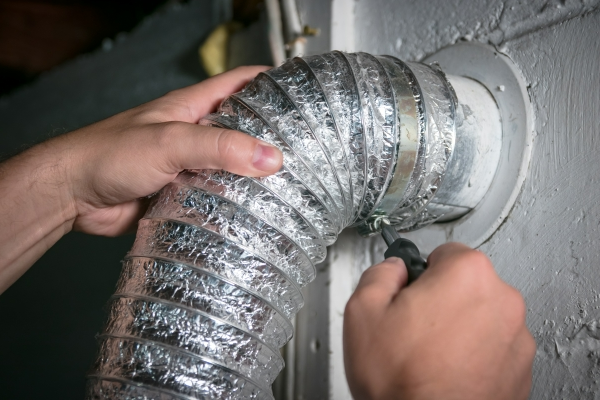Typical Dryer Vent Locations

As long as your dryer continues to do its job, most homeowners don’t give much thought to the location of their dryer vent. However, depending on the location of your dryer, some vent locations are better than others, and some you should try to avoid.
Ideally, your dryer should have exhaust vents that lead outside to keep your laundry area clean and less humid. The most common place to vent your dryer is horizontally through the exterior wall near the dryer, which is the ideal placement. Other common locations are through (but not into) the basement or the attic/roof.
For most dryer models, you can’t run the exhaust duct more than 25 feet from the dryer to the exhaust port. Ducts should be as short and straight as possible to reduce lint buildup. Read on to learn more about the nuances of correctly venting a dryer so you can get your laundry dry and keep you and your family safe.
Where Does a Dryer Vent Go—And Not Go?
These are good-to-go dryer vent locations:
-
Venting through any exterior wall. Even if your washer/dryer setup is in the middle of your home, your dryer should vent to the exterior on the shortest, straightest path possible.
-
Venting from the basement to the outside. Many dryers are installed in the basement to keep them out of the way. If your house is already set up like this and you’re trying to locate the exhaust vent outside your home, look for a wedge-shaped plastic or metal hood about a foot or two from the ground.
-
Venting from the attic through the roof—if done properly. Venting from the roof is not an amazing option because of the higher likelihood of obstructions due to animal activity and longer ducts. But sometimes it’s the only option. Make sure you don’t have a dryer vent into your attic; it should go all the way outside through a system designed specifically for roofs. It’s important to keep dryer vents clean, but roof vents are harder to clean on your own. We’d recommend contacting our dryer vent cleaning experts.
-
Venting through a window. In a pinch, you can vent your dryer out a window. Someone might do this if they’re building a house and currently waiting for professional dryer installation or if they own a portable clothes dryer.
Avoid these dryer ventilation setups:
-
Putting a dryer vent in a crawl space. While a dryer duct can run through a crawl space, it should never vent into a crawl space. Even with a lint bag that prevents debris from flying everywhere, if you vent all the moist air into your crawl space, it will create a prime home for mold and mildew, a serious fire risk, and a carbon monoxide risk (with a gas dryer). If you must vent through the crawlspace to the outdoors, make sure an expert does the job, as specific materials are required for this type of system.
-
Venting inside the garage. Your dryer shouldn’t vent into your garage because of health and safety concerns. Consider the garage as part of the “don’t vent inside the house” rule.
-
Venting across the whole house. Dryer ducts have a maximum length of 25 feet from the dryer to the outside exhaust vent. That’s why dryers are often placed against exterior walls. A specialized dryer vent exhaust fan helps keep damp lint and air moving in extra-long vents, but this isn’t as safe of a solution as having a shorter duct.
-
Venting next to outdoor appliances. If you have external appliances like a furnace vent intake, an air conditioning unit, or outdoor kitchen appliances, your dryer vent should be at least a few feet away from these. This protects those exterior appliances from being damaged by hot, moist air and lint buildup.
Related Topic: What to Do About Birds in a Dryer Vent
Wondering How to Vent a Dryer in a Basement?
You shouldn’t vent your dryer directly into your basement. The hot, wet air would cause a major mold problem, and free-floating lint can quickly build up to create a fire hazard. Finally, in many locations, building codes do not allow for this setup.
It's easy to get an exterior vent installed from the basement to the exterior if you have basement laundry machines.
Rules for Installing Dryer Vents High and Low
There are a few rules of thumb for installing a dryer vent—or for scoping out a vent location so you can get it installed by experts:
-
Calculate distance. The standard maximum distance your dryer duct can run is 25 feet from end to end. Some brands can go up to 35 feet, but you’ll need to check manufacturer instructions and local regulations. If your duct needs to make turns to reach the outside, subtract 2.5 feet from your max distance for every 45-degree turn and 5 feet for every 90-degree turn.
-
Prevent lint accidents. Wet air won’t be the only thing coming out of your dryer exhaust vent. Place the vent away from other appliances and home systems to prevent lint from clogging other systems.
-
Choose strong duct material. Flexible plastic ducts with ridging are harder to clean, trap more lint, and sag and tear more easily. Plus, they’re not up to code in many areas. For best results in most situations, use a 4-inch rigid metal duct pipe.
-
Seal the joints. To avoid leakage, seal the duct joints with foil duct tape, not just screws or clips. Pay special attention to the connection between the duct and the outside vent.
-
Keep things warm. If your duct runs through a non-insulated section of your house—like a garage, attic, or basement—it needs to be insulated, so the moist air inside doesn’t freeze or condense.
-
Hang your ductwork. Sagging ducts make your dryer work harder as it tries to push lint out. This can lead to clogs. Hang ductwork from floor or wall joists to avoid sagging.
Keep Your Dryer and Your Vent in Great Shape
While venting a dryer to the inside of your home is off the table, there are plenty of suitable dryer vent locations. If you need to ensure your dryer is vented correctly and working properly, contact your local Mr. Appliance for help. We offer vent repairs, cleaning, installation, and dryer repairs. Give us a call or schedule an appointment online today.
 Click to call
Click to call


